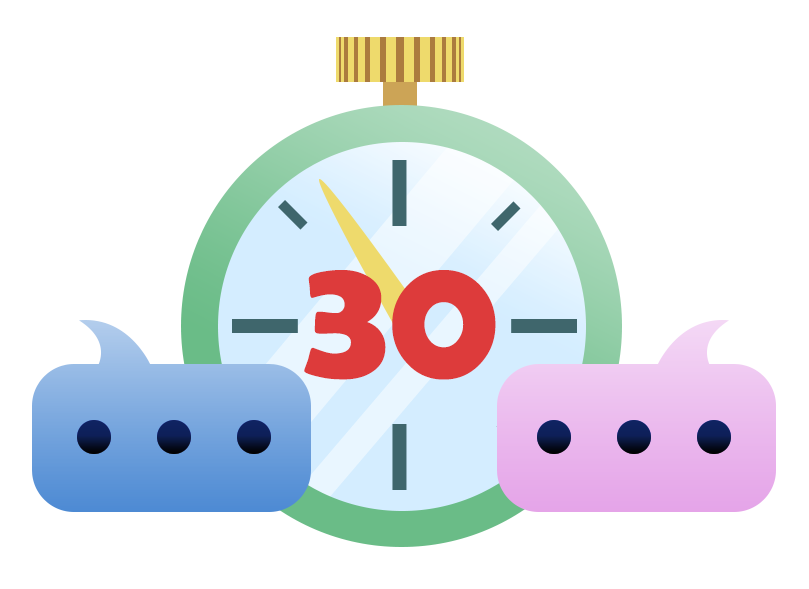
Grade Level
This instructional strategy allows participants to “park” questions for later resolution. Read more »
Group Size
Placement In Lesson
Time To Complete
Intention Or Purpose
Grade Level

Grade Level
Students collaborate to determine their response to a prompt and then create a short video to communicate that response in a creative way. Read more »
Placement In Lesson
Time To Complete
Intention Or Purpose
Grade Level

Grade Level
This collaborative strategy can be used to introduce new material or to review texts that students have read. 30-Second Expert helps students summarize and synthesize information in a brief, reciprocal activity. Read more »
Group Size
Placement In Lesson
Time To Complete
Intention Or Purpose
Grade Level

Grade Level
Students synthesize and summarize their understanding of a novel, historical event, or time period by creating a single image made from different components, similar to the composition of Japanese meals served in a compartmentalized box. Read more »
Group Size
Placement In Lesson
Time To Complete
Intention Or Purpose
Grade Level

Grade Level
Students collaborate to summarize content, create illustrations, and record a brief video about a research topic or recently covered topic that demonstrates their expertise and understanding. Read more »
Group Size
Placement In Lesson
Time To Complete
Intention Or Purpose
Grade Level

In this lesson, students will understand the essential elements of identity theft and consumer fraud. They will create a PSA-style poster or video about how to avoid identity theft. This lesson includes optional modifications for distance learning. Resources for use in Google Classroom are included. Read more »
Standard 9: Identity Theft
Related
Grade Level
Subject
Course
Standards

Students will understand the various forms of bankruptcy, how bankruptcy can occur, and alternatives to bankruptcy. This lesson includes optional modifications for distance learning. Resources for use in Google Classroom are included. Read more »
Standard 13: Bankruptcy
Grade Level
Subject
Course
Standards

In this lesson, students will identify organizations within the community that help people meet their basic needs. Students will discuss why people help one another and the potential impact of these decisions on society. Next, they will investigate a charitable organization, its founding, its current... Read more »
Standard 14: Charitable Giving
Related
Grade Level
Subject
Course
Standards

Students will conduct a data-driven lab using common human phenotypes and present their findings to their peers in a Gallery Walk. Common genetic vocabulary will be researched by students and they will present their findings to the class. Students will connect common genetic themes with their earlier... Read more »
Mendelian Genetics
Grade Level
Subject
Course
Standards

In this lesson, students explore the essential questions "Who am I?" and "What makes me me?" through multimodal narrative writing. For this creative composition, students engage in preliminary reflective writing and in an up-close look at their thumbprints. Throughout this creative writing process,... Read more »
Thumbprint Autobiography
Subject
Course
Grade Level
Standards

This grammar lesson will engage students in recognizing, identifying, and creating active or passive voice in their writing. The use of active and passive voice is demonstrated through the short story, "The Monkey's Paw," although any piece of literature could be substituted. This lesson includes optional... Read more »
Grammar/Language Usage
Subject
Course
Grade Level
Standards

This lesson addresses the components of evidence used to support hypotheses, as well as qualitative versus quantitative and primary versus secondary. This would be a good lesson to start the year and requires no prerequisite skills. This lesson includes optional modifications for distance learning.... Read more »
Experimental Components
Related
Grade Level
Subject

Acquiring the use of a car is a rite of passage for high school students. In this personal financial literacy lesson, students will investigate the cost of a car, types of lending agencies, and additional costs associated with car ownership. This lesson does require that students have access to the... Read more »
Standard 7: Understanding Loans
Related
Grade Level
Subject
Course
Standards

Formulating Statistical Hypotheses and Hypothesis Testing
Grade Level
In this lesson, students will explore the concepts of statistical hypotheses by looking at what a statistical hypothesis is, how they are formed, and some methods of testing them. Once they have been introduced to the basic concepts, they will be able to apply these concepts by playing Potions!, a digital... Read more »
Formulating Statistical Hypotheses and Hypothesis Testing
Related
Grade Level
Course
Standards

Students will use text analysis strategies to summarize two significant events of the Revolutionary War—the Battle of Saratoga and the French Alliance. Then students, working in collaborative groups, will use their knowledge of these events to annotate the lyrics of the song "Guns and Ships" from the... Read more »
Battle of Saratoga and the French Alliance
Subject
Course
Grade Level
Standards

Rethinking the Words of the Declaration of Independence
Grade Level
Students, working in groups, use a "paired-text" strategy to analyze letters between Abigail and John Adams and the song "The Schuyler Sisters." Students create a "third text" by creating a hypothetical conversation between Abigail Adams and Angelica Schuyler regarding political and social issues facing... Read more »
Rethinking the Words of the Declaration of Independence
Subject
Course
Grade Level
Standards

How do you persuade others? How did the characters in Shakespeare's "Julius Caesar" use ethos, pathos, and logos to sway the minds of the Roman people? This lesson explores the three modes of persuasion and invites students to analyze and notate the speeches in Shakespeare's tragedy for ethos, pathos,... Read more »
Julius Caesar
Subject
Course
Grade Level
Standards

In this lesson about the use of media to inform public opinion and effect social change, students will begin by viewing two short interviews, then reflecting on their beliefs about the role of journalism in a democratic society. Next, students will analyze 19th-century media by reading excerpts from... Read more »
The Media and the Abolitionist Movement
Related
Subject
Course
Grade Level
Standards

In this lesson, students will explore the meaning and application of the Bill of Rights. Students will summarize each amendment from the Bill of Rights in their own words and discuss the application of each amendment. Students will then discuss whether or not "ballot selfies" should be a protected form... Read more »
Interpreting the Bill of Rights
Subject
Course
Grade Level
Standards

In this lesson, students will work together to determine the definition of desertification and create a chart to explain the causes and effects of desertification in the sub-Saharan Sahel region. Then, students will learn how Africa is responding to desertification with a project called the Great Green... Read more »
Desertification of the Sahel
Subject
Course
Grade Level
Standards

This lesson focuses on teaching students how to solve algebraic equations using student-friendly language. Students will begin by trying to solve viral math posts in groups. Next, they will learn the "Do/Undo" method for solving equations. Finally, students will create their own viral math posts and... Read more »
Solving Equations
Course
Subject
Grade Level
Standards

This stress management lesson will challenge students' ideas about stress and its effects on the body. Students will participate in a high-pressure competitive activity, learn about good and bad stress, research and evaluate articles about stress, and create SMART goals for stress management. By the... Read more »
Stress Management
Grade Level
Standards

This lesson engages students in exploring, assessing, and drawing conclusions about the validity of various media sources through exploration of the 2019 "Alienstock" phenomenon. Students will work independently and in groups to compare and analyze different media sources and evaluate the validity and... Read more »
Analyzing Information, Media, and Validity
Subject
Grade Level
Standards

This lesson invites students to explore scientific models and simulations to learn about climate and weather phenomena. Students will learn from a meteorologist about how those in the field of climatology use math and science in their careers, as well as the details of this job and career path. By the... Read more »
ICAP Science: Weather
Related
Grade Level
Subject
Standards

Observing a polyurea-coated watermelon dropping from a 148-foot drop as a phenomenon, students will develop an understanding of how the coating is formed via a chemical reaction and what properties make the substance so durable. Through models and observational data, students will explain how the molecular... Read more »
Chemical Properties and Reactions
Grade Level
Subject
Course
Standards

Students will explore the flow of energy among living organisms by constructing a food web consisting of the organisms that inhabit a salt marsh. This lesson includes optional modifications for distance learning. Resources for use in Google Classroom are included. Read more »
Food Webs
Grade Level
Subject
Standards

This lesson, based on W.W. Jacob's short story "The Monkey's Paw," is designed to help students understand foreshadowing. Students identify passages in the text that foreshadow the end of the story and predict how they think the story will end. After reading the full story, students compare their predictions... Read more »
Foreshadowing
Subject
Course
Grade Level
Standards

Interdependence of Science, Engineering, and Technology on Society and the Natural World
Grade Level
In this lesson on the interdependence of science, engineering, and technology, students will use the example of snake venom to explore how natural resources can be used to make synthetic products that humans rely on. Students will learn and practice research strategies and evaluate sources. Finally,... Read more »
Interdependence of Science, Engineering, and Technology on Society and the Natural World
Grade Level
Subject
Standards

Standard 8: Interest, Credit Cards, and Online Commerce
Grade Level
In this lesson, students will discuss the pros and cons of online shopping and learn how to protect their online identities. Through a variety of scenarios, students will determine when is best to use a credit card or a debit card, as well as options for payments on credit cards. This lesson includes... Read more »
Standard 8: Interest, Credit Cards, and Online Commerce
Related
Grade Level
Subject
Course
Standards

This lesson uses the book "P Is for Pterodactyl: The Worst Alphabet Book Ever" by Raj Haldar and Chris Carpenter to teach digraphs and nuances of phonetics in the English language. Students will brainstorm to identify other digraph words in their vocabularies, write and draw their own pages for a sequel... Read more »
Phonics
Grade Level
Subject
Standards

Students will examine the book "If You Give a Mouse a Cookie" by Laura Joffe Numeroff to learn about the conditional mood. After deconstructing, reconstructing, and creating their own conditional sentences, students will write collaborative Chain Stories in a narrative style similar to Joffe's book,... Read more »
Conditional Statements
Subject
Course
Grade Level
Standards

How Did the Constitution Protect the System of Slavery?
Grade Level
Students will listen to a New York Times podcast discussing the contradiction in the Constitution by which it protects both freedom and slavery. Working in collaborative groups, students will summarize four parts of the Constitution—the Three-Fifths Clause, the Fugitive Slave Clause, the Slave Trade... Read more »
How Did the Constitution Protect the System of Slavery?
Subject
Course
Grade Level
Standards

In this lesson, students become familiar with identifying, locating, and analyzing persuasive techniques in writing and multimodal compositions, including their own, by examining the ways in which commercials and infomercials employ these techniques. Using their new knowledge, students will write a... Read more »
Persuading Your Audience
Grade Level
Subject
Standards

This lesson provides an overview of ethical theory and integrity through discussion, reflection, and game-based learning. Through this lesson, students will gain a basic understanding of three common ethical frameworks: deontology, consequentialism, and virtue theory. They will come to understand that... Read more »
Ethics
Related
Grade Level
Subject
Course
Standards

Students will examine different types of insurance and learn about what each type insures. They will identify appropriate amounts of insurance, learn insurance terms, and learn how insurance deductibles work. This lesson includes optional modifications for distance learning. Resources for use in Google... Read more »
Standard 11: Insurance
Related
Grade Level
Subject
Course
Standards

In this lesson on the importance of clean water as a natural resource, students will begin by observing a polluted water source within a United States community. Next, students will explore the significance of the Ganges River and the political and religious issues that impact the ongoing struggle to... Read more »
Ganges River Pollution
Related
Grade Level
Subject
Course
Standards

This lesson has students consider different perspectives in the Civil War. Students will participate in a role-playing activity to become familiar with the different motives and points of view of various key figures in the Civil War, then analyze these key figures in greater depth during a discussion.... Read more »
Perspectives in the Civil War
Subject
Course
Grade Level
Standards

In this lesson about the Industrial Revolution, students will begin by observing photographs of factory workers and analyzing primary sources to make inferences about working conditions during the Industrial Revolution. Based on the information they gather, students will write a letter protesting working... Read more »
The Industrial Revolution
Related
Subject
Course
Grade Level
Standards

In this middle school lesson, best facilitated at the beginning of a westward expansion unit, students analyze John Gast's painting "American Progress," then read and analyze primary source documents to construct their own definition of "Manifest Destiny." To deepen their understanding, students analyze... Read more »
U.S. Territorial Expansion
Subject
Course
Grade Level
Standards

This lesson will serve as an introductory unit covering four major types of speeches: informative, demonstrative, persuasive, and special occasion (extemporaneous). Students will watch videos demonstrating these four types of speeches, then collaborate to create a brief presentation on one type of their... Read more »
Four Categories of Speeches
Grade Level
Subject
Course
Standards

In this lesson about the journalism writing process and the role of a copy editor, students will explore the importance of grammar and style. Students will work in groups to identify the key elements of a news story through a Card Sort. Then, students will work independently to practice editing a paragraph... Read more »
Copy Editing and the Writing Process
Related
Subject
Course
Grade Level
Standards

In this lesson, students will explore the odds of winning in games of chance and discover the problems associated with gambling. They will participate in a game of dice, read personal stories, and create their own PSAs about the dangers of gambling addiction. This lesson includes optional modifications... Read more »
Standard 12: Gambling
Related
Grade Level
Subject
Course
Standards

This short, introductory lesson is a great way to begin the year in any history class from 8th-12th grade. Each student will create their own definition of history then compare it to quotes about history and the term's dictionary definition. Students then will reexamine their own definitions, modify... Read more »
Intro to History
Grade Level
Subject
Course
Standards

In this lesson, students explore the relationship between a set of numbers and the constraints of an inequality. They will write, graph, and identify solutions to inequalities and connect these to real-world scenarios when applicable. Read more »
One-Step Inequalities
Course
Subject
Grade Level
Standards

Renaissance artists like Michelangelo, Leonardo da Vinci, Raphael, and Donatello are key figures in the realms of both history and art, but some students might recognize their names only from a particular popular cartoon series. This lesson focuses on the iconic art of the Renaissance and allows students... Read more »
World History and the Renaissance
Grade Level
Subject
Course
Standards

In this lesson, students will make observations and inferences about policies leading to a history of native peoples being dispossessed of their land. Students will explore the policy of allotment by participating in a simulation activity and completing an article analysis. To extend their learning,... Read more »
Land Openings in Indian Territory
Subject
Course
Grade Level
Standards

This lesson explores the impact of the Civil War and Reconstruction on the Five Tribes. Students will begin this lesson with a Word Splash activity to activate their prior knowledge about the Five Tribes' involvement in the Civil War. Next, students will explore the Reconstruction Treaties of 1866 (treaties... Read more »
The Reconstruction in Indian Territory
Subject
Course
Grade Level
Standards

Setting and Conflict
In this lesson, students experiment with changing the settings in well-known fairy tales and examine how conflict might change in a different setting. Students explore the Prologue from Shakespeare's "Romeo and Juliet" and analyze how the setting affects the conflict. After analyzing and comparing different... Read more »

This lesson focuses on comparing and contrasting fiction and nonfiction, writing a researchable inquiry question, and developing justice-based research questions. Students will familiarize themselves with the Tulsa Race Massacre and then read an excerpt from the novel "Dreamland Burning," followed by... Read more »
Guided Inquiry Research
Subject
Course
Grade Level
Standards

Digital Storytelling with Green Screen
Grade Level
Through digital storytelling, students will create projects that showcase creativity, teamwork, and writing across the curriculum. This lesson engages teachers in using a green screen, the Do Ink app, and a movie editing application like iMovie to transport them to the world of students reporting on... Read more »
Digital Storytelling with Green Screen
Subject
Grade Level
Related

Human-Environment Interaction
Grade Level
In this lesson, students learn about the story of the near extermination and subsequent re-introduction of the Gray Wolf of Yellowstone National Park. Through this narrative, students learn about apex predators, keystone species, and ecosystems. They learn to form cause and effect statements, analyze... Read more »
Human-Environment Interaction
Subject
Course
Grade Level
Standards

Observations and Inferences
Grade Level
In this lesson, students play the role of a nosy detective, digging through a mysterious neighbor's garbage to make observations and inferences in order to solve a case. Using images and "artifacts," students create a character profile to show how their observations and inferences help them come to... Read more »
Observations and Inferences
Grade Level
Subject
Standards

Colloquial language is informal and consists of words or phrases known primarily to native speakers of a language. In this lesson, students will examine not only how familiar they are with English colloquialisms, but also how often these colloquialisms are used in our speaking and writing, and the effect... Read more »
Colloquial Language
Subject
Grade Level
Standards

In this lesson, students explore the idea of superstitions and ghost stories and how they affect people and their emotions and behaviors. Students read “The Legend of Sleepy Hollow” by Washington Irving and examine how the two main characters react to and are affected by the legend of the headless... Read more »
Characters' Differing Perspectives
Subject
Course
Grade Level
Standards

Sometimes, we know a great deal about the meaning and inspiration behind a work of art. In many cases, the artist has left information about their art in an artist's statement. Sometimes though, it is up to the viewer to construct their own meaning of a work of art, regardless of what information about... Read more »
Ekphrastic Poetry
Subject
Course
Grade Level
Standards

Character Development and Theme in "The Scarlet Ibis"
Grade Level
This lesson has students connect the theme of regret across poems, songs, nonfiction, and short stories to explore how social-emotional factors can affect character development and theme. Students work independently to write their own apology note as well as write an apology from the perspective of... Read more »
Character Development and Theme in "The Scarlet Ibis"
Subject
Course
Grade Level
Standards

In this lesson, students compare and contrast the poem, "The Hill We Climb," with an excerpt from the speech, "I Have a Dream," and analyze how the authors' messages are made clear through their word choices and rhetorical strategies. Students compose a poem, evaluate how poetry can be used to send... Read more »
Perspectives in Poetry
Subject
Course
Grade Level
Standards

Truth is a powerful thing. Sometimes it hurts, and sometimes it is hard to deliver. In this multi-genre lesson, students will analyze and compare three texts written on the subject of honesty. Students will determine the claim a text is arguing and the evidence and reasoning that is used to support... Read more »
Claim, Evidence, Reasoning
Grade Level
Subject
Standards

In this lesson, students will explore the meaning of the word "parallel" and analyze how and for what purposes parallel structure is used in speeches. At the end of the lesson, students will compose a tweet to summarize the purpose of parallel structure in writing. This lesson includes optional modifications... Read more »
Parallel Structure
Subject
Grade Level
Standards

Is lettuce interesting? The answer depends on whom you ask. Whether the subject of lettuce is personally captivating or not, a good essay on the subject requires a thesis statement to organize the text and to keep the reader oriented and focused. A strong thesis statement not only helps the reader,... Read more »
Writing a Thesis Statement
Subject
Course
Grade Level
Standards

In this lesson, students will begin by analyzing two images depicting the Washita Massacre to generate hypotheses about what happened during this historical event. Next, students will read and analyze an article and complete a corresponding history frame graphic organizer. As an extension, students... Read more »
The Indian Wars in Indian Territory
Grade Level
Subject
Course
Standards

This lesson focuses on the relationship between a set of numbers and the constraints of an inequality. Students write, graph, and identify solutions to inequalities, connecting them back to real-world scenarios when applicable. Read more »
Multi-Step Inequalities
Course
Subject
Grade Level
Standards

This activity focuses on eliminating the emotional fear of mathematics by allowing students to evaluate where they are on the math spectrum and identify their goals moving forward. This is a great activity to do not only in the first days of school but also to revisit multiple times a year. The Extend... Read more »
Target Audience
Calendar Placement
Group Size
Intention Or Purpose
Family Engagement

